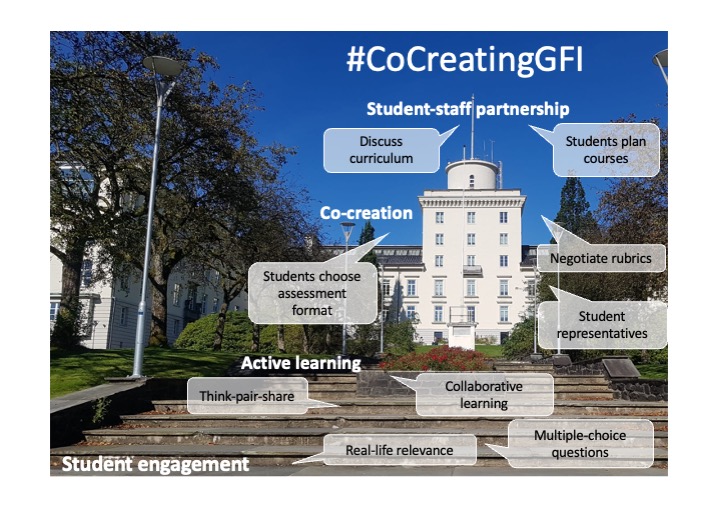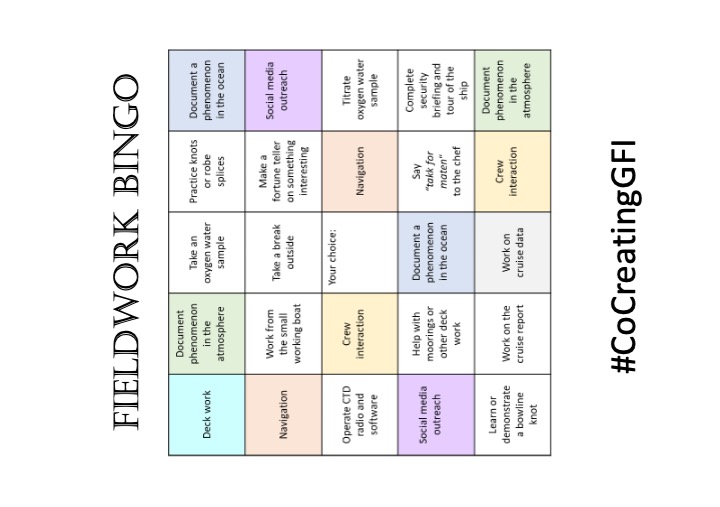
Designing postcards to inspire discussion about co-creation methods
One deliverable in our #CoCreatingGFI project (which has a new website! Check it out here!) are a set of postcards to share our experiences with co-creation with other teachers and students — to invite discussions and inspire them to adapt the ideas for their own purposes. And we have designed the first five now! Click on images below for pdf downloads (The backsides contain space for all the usual postcard stuff [i.e. address and a message], plus a short explanatory text, and link & QR code to the website).
The choice of methods is partly driven by what we could easily find ways to illustrate, and partly by what we really like. So we start out with my favorite “start, stop, continue” method with a twist: We don’t only ask students what we as teachers should “continue, start, stop” to improve their learning, but also what they themselves could “continue, start, stop” for the same purpose. I think this is such a great way to get constructive thoughts and conversations going!

Asking what the teacher can “stop, continue, start” (Hoon et al., 2015) gives us formative feedback to improve our teaching. But what if we ask students the same question so they use the evaluation to reflect on and improve their own learning (Bovill, 2011)?
The next postcard is about another question I like to add to the “continue, start, stop” questions above, and that is about “what did you want to say, but did not get the chance?“. The purpose here is to include voices of those students who might not be quick to speak up, or might not have wanted to interrupt a conversation, or for what ever reason self-censored. If what they wanted to say is still relevant to them even after the conversation has moved on, it is usually very worthwhile for us to hear about!

There are many reasons why interesting points never make it from participants’ heads into a discussion. You could ask for them in an anonymous online forum after class. That might surface interesting thoughts, as well as give students confidence that their input is valued, which makes it easier to speak up in class in the future.
Then we have the “co-created dictionary”: Students collect (or teacher suggests) relevant terms that the students then write explanations for. The teacher can approve or correct, and over time this builds a great collection!

Co-create dictionaries: Students learn many new words and terms during a course. Try to create a shared dictionary resource. The teacher suggest words and terms, students can add their own terms, and students fill in explanations with their own words. The teacher can modify and accept the explanations at a set date before the exam preparations start.
This postcard is about the “co-creation ladder” visualizing the spectrum from active learning towards student-staff partnership.

#CoCreatingGFI is a HK-dir-funded project where students and staff at the Geophysical Institute, University of Bergen, Norway, work towards climbing the steps towards co-creating learning and teaching. Here are some examples of methods and learning activities, and ideas for sharing responsibility for learning.
And lastly, we have our “fieldwork bingo”! Which we actually tested on the recent student cruise, but I still have to write up a blogpost about the experience. But in a nutshell: Works well to get students engaged in a multitude of different activities of their choice!

Make the most out of your field work: Students often don’t know what to do in the field, and there may be a lot of waiting. By equipping students with an activity bingo, they can cover a range of activities that are encouraged, but not necessarily obvious for students to take part in during their fieldwork.